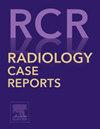4例棉丝瘤的CT表现及手术治疗
Q4 Medicine
引用次数: 0
摘要
棉棉瘤,也被称为肌理瘤或残留的手术海绵,是指手术后无意中留在体腔内的异物,如棉花或海绵残留物。棉丝瘤的确切流行率很难确定,主要是由于对法律和伦理影响的担忧,这导致了此类病例的低报。这些异物可以在手术后的不同时间点出现,从早期恢复阶段到手术后几十年的任何时间出现症状。这种不常见的并发症通常模仿肿瘤或肿块的外观,造成诊断困难和进一步并发症的高风险。在没有影像辅助的情况下诊断棉丝瘤仍然具有挑战性,这使得准确的检测更加难以实现。在本研究中,我们重点介绍了4例不同的棉丝瘤病例,每个病例都有独特的临床表现和位置,通过CT成像和随后的手术干预证实。本文章由计算机程序翻译,如有差异,请以英文原文为准。
CT features and surgical management of gossypiboma: A report of four cases
Gossypibomas, which are also referred to as textilomas or retained surgical sponges, represent foreign materials, such as cotton or sponge remnants, that are unintentionally left within a body cavity following surgical procedures. The exact prevalence of gossypibomas is difficult to determine, primarily due to concerns surrounding legal and ethical implications, which contribute to the under-reporting of such cases. These foreign objects can present at various points post-surgery, with symptoms appearing anywhere from the early recovery phase to decades after the procedure. This uncommon complication often mimics the appearance of a tumor or mass, creating diagnostic difficulties and a higher risk for further complications. Diagnosing gossypibomas remains challenging without the aid of imaging, making accurate detection harder to achieve. In this study, we highlight four distinct cases of gossypiboma, each with unique clinical manifestations and locations, confirmed through CT imaging and subsequent surgical intervention.
求助全文
通过发布文献求助,成功后即可免费获取论文全文。
去求助
来源期刊

Radiology Case Reports
Medicine-Radiology, Nuclear Medicine and Imaging
CiteScore
1.10
自引率
0.00%
发文量
1074
审稿时长
30 days
期刊介绍:
The content of this journal is exclusively case reports that feature diagnostic imaging. Categories in which case reports can be placed include the musculoskeletal system, spine, central nervous system, head and neck, cardiovascular, chest, gastrointestinal, genitourinary, multisystem, pediatric, emergency, women''s imaging, oncologic, normal variants, medical devices, foreign bodies, interventional radiology, nuclear medicine, molecular imaging, ultrasonography, imaging artifacts, forensic, anthropological, and medical-legal. Articles must be well-documented and include a review of the appropriate literature.
 求助内容:
求助内容: 应助结果提醒方式:
应助结果提醒方式:


